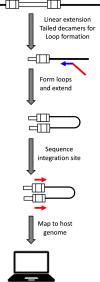The role of integration and clonal expansion in HIV infection: live long and prosper
- PMID: 30352600
- PMCID: PMC6199739
- DOI: 10.1186/s12977-018-0448-8
The role of integration and clonal expansion in HIV infection: live long and prosper
Abstract
Integration of viral DNA into the host genome is a central event in the replication cycle and the pathogenesis of retroviruses, including HIV. Although most cells infected with HIV are rapidly eliminated in vivo, HIV also infects long-lived cells that persist during combination antiretroviral therapy (cART). Cells with replication competent HIV proviruses form a reservoir that persists despite cART and such reservoirs are at the center of efforts to eradicate or control infection without cART. The mechanisms of persistence of these chronically infected long-lived cells is uncertain, but recent research has demonstrated that the presence of the HIV provirus has enduring effects on infected cells. Cells with integrated proviruses may persist for many years, undergo clonal expansion, and produce replication competent HIV. Even proviruses with defective genomes can produce HIV RNA and may contribute to ongoing HIV pathogenesis. New analyses of HIV infected cells suggest that over time on cART, there is a shift in the composition of the population of HIV infected cells, with the infected cells that persist over prolonged periods having proviruses integrated in genes associated with regulation of cell growth. In several cases, strong evidence indicates the presence of the provirus in specific genes may determine persistence, proliferation, or both. These data have raised the intriguing possibility that after cART is introduced, a selection process enriches for cells with proviruses integrated in genes associated with cell growth regulation. The dynamic nature of populations of cells infected with HIV during cART is not well understood, but is likely to have a profound influence on the composition of the HIV reservoir with critical consequences for HIV eradication and control strategies. As such, integration studies will shed light on understanding viral persistence and inform eradication and control strategies. Here we review the process of HIV integration, the role that integration plays in persistence, clonal expansion of the HIV reservoir, and highlight current challenges and outstanding questions for future research.
Keywords: Clonal expansion; HIV persistence; HIV reservoirs; Proviral integration.
Figures




Similar articles
-
The role of HIV integration in viral persistence: no more whistling past the proviral graveyard.J Clin Invest. 2016 Feb;126(2):438-47. doi: 10.1172/JCI80564. Epub 2016 Feb 1. J Clin Invest. 2016. PMID: 26829624 Free PMC article. Review.
-
Genetic Diversity, Compartmentalization, and Age of HIV Proviruses Persisting in CD4+ T Cell Subsets during Long-Term Combination Antiretroviral Therapy.J Virol. 2020 Feb 14;94(5):e01786-19. doi: 10.1128/JVI.01786-19. Print 2020 Feb 14. J Virol. 2020. PMID: 31776273 Free PMC article.
-
Dynamic Shifts in the HIV Proviral Landscape During Long Term Combination Antiretroviral Therapy: Implications for Persistence and Control of HIV Infections.Viruses. 2020 Jan 25;12(2):136. doi: 10.3390/v12020136. Viruses. 2020. PMID: 31991737 Free PMC article.
-
Early Emergence and Long-Term Persistence of HIV-Infected T-Cell Clones in Children.mBio. 2021 Apr 8;12(2):e00568-21. doi: 10.1128/mBio.00568-21. mBio. 2021. PMID: 33832973 Free PMC article.
-
The forces driving clonal expansion of the HIV-1 latent reservoir.Virol J. 2020 Jan 7;17(1):4. doi: 10.1186/s12985-019-1276-8. Virol J. 2020. PMID: 31910871 Free PMC article. Review.
Cited by
-
Residual Proviral Reservoirs: A High Risk for HIV Persistence and Driving Forces for Viral Rebound after Analytical Treatment Interruption.Viruses. 2021 Feb 21;13(2):335. doi: 10.3390/v13020335. Viruses. 2021. PMID: 33670027 Free PMC article. Review.
-
PCIP-seq: simultaneous sequencing of integrated viral genomes and their insertion sites with long reads.Genome Biol. 2021 Apr 6;22(1):97. doi: 10.1186/s13059-021-02307-0. Genome Biol. 2021. PMID: 33823910 Free PMC article.
-
Viral Causality of Human Cancer and Potential Roles of Human Endogenous Retroviruses in the Multi-Omics Era: An Evolutionary Epidemiology Review.Front Oncol. 2021 Oct 29;11:687631. doi: 10.3389/fonc.2021.687631. eCollection 2021. Front Oncol. 2021. PMID: 34778024 Free PMC article. Review.
-
Visualization of clonal expansion after massive depletion of cells carrying the bovine leukemia virus (BLV) integration sites during the course of disease progression in a BLV naturally-infected cow: a case report.Retrovirology. 2022 Nov 3;19(1):24. doi: 10.1186/s12977-022-00609-0. Retrovirology. 2022. PMID: 36329491 Free PMC article.
-
Intact provirus and integration sites analysis in acute HIV-1 infection and changes after one year of early antiviral therapy.J Virus Erad. 2022 Dec 10;8(4):100306. doi: 10.1016/j.jve.2022.100306. eCollection 2022 Dec. J Virus Erad. 2022. PMID: 36582472 Free PMC article.
References
-
- Palmer S, Maldarelli F, Wiegand A, Bernstein B, Hanna GJ, Brun SC, Kempf DJ, Mellors JW, Coffin JM, King MS. Low-level viremia persists for at least 7 years in patients on suppressive antiretroviral therapy. Proc Natl Acad Sci USA. 2008;105(10):3879–3884. doi: 10.1073/pnas.0800050105. - DOI - PMC - PubMed
-
- Palella FJ, Jr, Delaney KM, Moorman AC, Loveless MO, Fuhrer J, Satten GA, Aschman DJ, Holmberg SD. Declining morbidity and mortality among patients with advanced human immunodeficiency virus infection. HIV outpatient study investigators. N Engl J Med. 1998;338(13):853–860. doi: 10.1056/NEJM199803263381301. - DOI - PubMed
-
- Palella FJ, Jr, Baker RK, Moorman AC, Chmiel JS, Wood KC, Brooks JT, Holmberg SD, Investigators HIVOS Mortality in the highly active antiretroviral therapy era: changing causes of death and disease in the HIV outpatient study. J Acquir Immune Defic Syndr. 2006;43(1):27–34. doi: 10.1097/01.qai.0000233310.90484.16. - DOI - PubMed
-
- d’Arminio Monforte A, Sabin CA, Phillips A, Sterne J, May M, Justice A, Dabis F, Grabar S, Ledergerber B, Gill J, Reiss P, Egger M, Antiretroviral Therapy Cohort C The changing incidence of AIDS events in patients receiving highly active antiretroviral therapy. Arch Intern Med. 2005;165(4):416–423. doi: 10.1001/archinte.165.4.416. - DOI - PubMed
-
- Mocroft A, Vella S, Benfield TL, Chiesi A, Miller V, Gargalianos P, d’Arminio Monforte A, Yust I, Bruun JN, Phillips AN, Lundgren JD. Changing patterns of mortality across Europe in patients infected with HIV-1. EuroSIDA Study Group. Lancet. 1998;352(9142):1725–1730. doi: 10.1016/S0140-6736(98)03201-2. - DOI - PubMed
Publication types
MeSH terms
Substances
Grants and funding
LinkOut - more resources
Full Text Sources
Other Literature Sources
Research Materials

